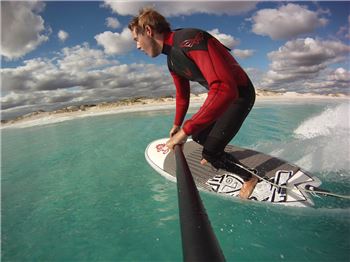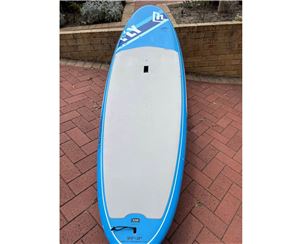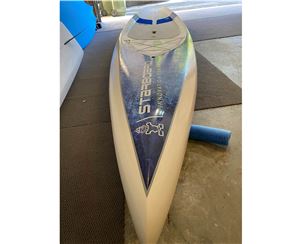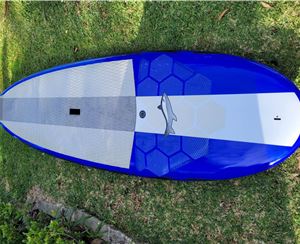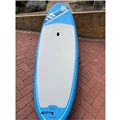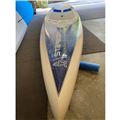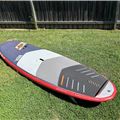SUP Surf Moves -the Cutback, Floater and Re-entry
Once you're comfortable out in the surf on your stand up paddleboard, it's time to broaden your horizons a little and to start tackling some more technical moves. Aside from giving your stand up paddleboarding heaps more style, the moves that we go over here are also highly functional in terms of surfing a wave to its full potential - if you can't cut-back or go over a broken section of the wave, then you aren't making the most of the wave...
The Cutback
An essential move on your SUP in most conditions, the cutback enables you to get your board back into the 'pocket' of the wave and generate more speed ready for your next move. It can also be an essential move if the surf's slow or small, as otherwise you'll just outrun the wave and game over!
- To line up your cutback you first need to choose the right section of the wave. A cutback is never performed in the most critical part of a wave, so if you're gunning it along then just keep going! When you see a flatter section (where the wave is less steep, or loses some power) then you need to get yourself about 2 board-lengths on to this section - remember that you need to turn your board back towards the wave and then get it back down the line so you need plenty of space.
- Once you've picked your spot ride your stand up paddleboard up towards the top of the wave, aiming for the point where you want to initiate your turn (if you're too low on the wave then you won't have enough power to complete the move).
- As you reach the point, move your weight back on the board (depending on where you are and size of your board, this may mean taking a couple of steps back), and begin to dig the tail in. As you become more proficient you can also dig your paddle into the side that you want the board to turn towards to initiate a quicker cutback.

- Begin the turn. Dig in your rail, keeping your weight through your back foot, and pull the board round. (Obviously the size of your board will have an impact on how quickly this happens). As the board comes round so that you're almost facing the wave begin to flatten the board out to generate some speed as you head back towards the wave.
- Two options next. 1) Aim to turn just before the broken section of the wave gets to you, or 2) Ride up onto broken section of the wave and then begin to turn. Either way you need to turn the board back aggressively.
- Use the power and angle of the wave to help you complete you turn, then aim your board back down-the-line with extra speed and bonus style points!
Although we've broken it down into stages here, in reality the cutback is one continuous move - almost like an extended 'S' - and can be as tight or as smooth as you like (or the conditions allow). Once you've got the principals wired though, it will be a staple in your stand up paddleboarding repertoire!
Floater
The floater is a classic move in most surfers' bags - it's a great way to clear a broken section of the wave, to maintain your speed if getting through a section looks a bit 50/50, and also a stylish way to end your ride if your wave closes out. It's a more challenging move on a stand up paddleboard than a shortboard primarily because you've got more board, and the top of a breaking wave ain't that stable! When done right though, a floater on a SUP is a super stylish move. Here's how to go about it:
- Unlike other moves, you can't really 'plan' a floater - the wave dictates whether the move is on or not! If there's a section up ahead of you that's closing out or starting to fold then that's the time to start planning a floater...
- You need to be travelling as fast as possible so, if your board lets you, put in a couple of pumps as you approach the section to give yourself maximum speed.
- When you're a couple of feet away from the broken section, initiate your turn up towards the top of the wave - as if you're going for a re-entry (see below). Get your board up to between 45 and 60 degrees. Use your paddle to drive the board around quickly if you can - you need to turn late and quick to keep as much speed as possible as you head up towards the top of the wave.
- Let your board ride up onto the wave. You just need to focus on keeping your balance here - pull your legs up if you need to, but the aim is to let your whole board ride up onto the section. If only your nose is up then that's not  a true floater!
a true floater!
- You're there! Now just keep looking down the line (not at the beach or your mates out back!) and assess how far you're going to float along the top. Again: the wave will probably dictate what your options are!
- When it's time to drop back down, you need to 'pop' your board back down towards the face of the wave - make sure that your back foot leads the move, if you just angle your board back down then the nose will dig in and you'll get nailed! If your tail lands first then that's fine - you'll have plenty of speed and should be able to get the nose down and be flying off down the line again. Use your arms and your paddle to keep yourself stable as you drop back onto the face, and then focus on what the next section is doing - maybe time to set up another floater!
The re-entry
The re-entry (or in more old school lingo, the off-the-lip) is one of the most striking surf moves - get it right and you should send some spray off the back of the wave and back toward the line up - get it really right and you might flash a bit of fin out the back of the wave! Again, the re-entry is a shortboarding move - the angle that you need to get your board at a truly 'radical' angle makes it very difficult on a stand up paddleboard unless the wave is a couple of feet bigger than the length of your board - i.e. BIG! This said, you can pull off cruisier re-entries where your board doesn't hit the lip at such an acute angle pretty much any day, and they're a great way to liven up your down the line riding.
- As with the floater, the wave will dictate when you can go for a re-entry. You need a vertical or a pitching section of the wave to send your stand up paddleboard onto - if you try the move on anything else then you'll just roll of the back of the wave. You'll often find that as soon as you take off (especially if you've gone late) that you spot a section that's starting to pitch.
- Throughout the move keep your eyes on the part of the wave that you want to hit: 1) because the wave, when this critical, will be changing quickly so you may need to make slight adjustments, and 2) your body will follow your head and lead you into the move.
- As you approach the section you  need to drop down the wave (so you're out in front of it) and then go into a fairly aggressive bottom turn. Whether you're riding frontside or backside will dictate how you pull this off, but either way you need to be riding the board from the tail and sending the nose back towards the wave nice and quickly. Dig in your paddle (and hang on to it!) to really drive the board around.
need to drop down the wave (so you're out in front of it) and then go into a fairly aggressive bottom turn. Whether you're riding frontside or backside will dictate how you pull this off, but either way you need to be riding the board from the tail and sending the nose back towards the wave nice and quickly. Dig in your paddle (and hang on to it!) to really drive the board around.
- As you head up the wave focus on the section that you're going to hit. You need aim to be beginning your turn as you hit the lip (or if it's smaller be around halfway through your turn).
- The key thing with the re-entry is that you shouldn't have to work too hard with it... As you're hitting the wave at a critical point it should have the power to send you and your board back down. So, as you feel your board connect with the breaking section, release your front foot and move your weight forward a little. This should drive your board up and allow it to pivot on the section.
- Having chucked plenty of spray out the back of the wave it's time to get on with your ride. Ensure that you're looking back down-the-line now, and absorb the landing with your knees, then get your balance and eyes down for the next section!


